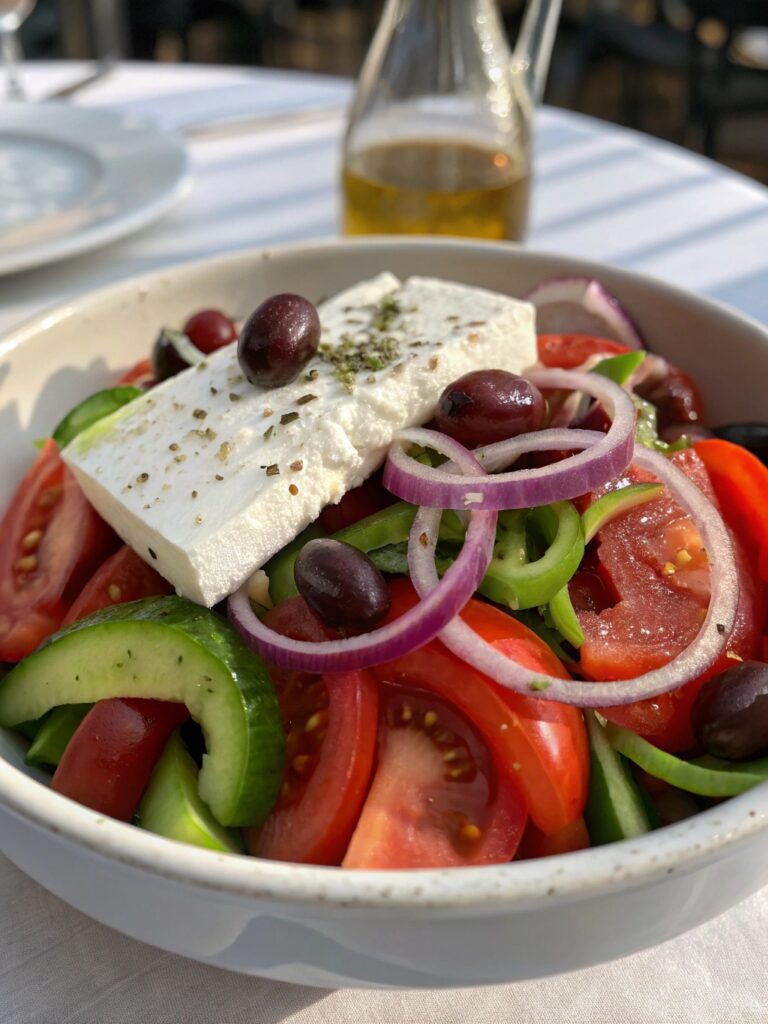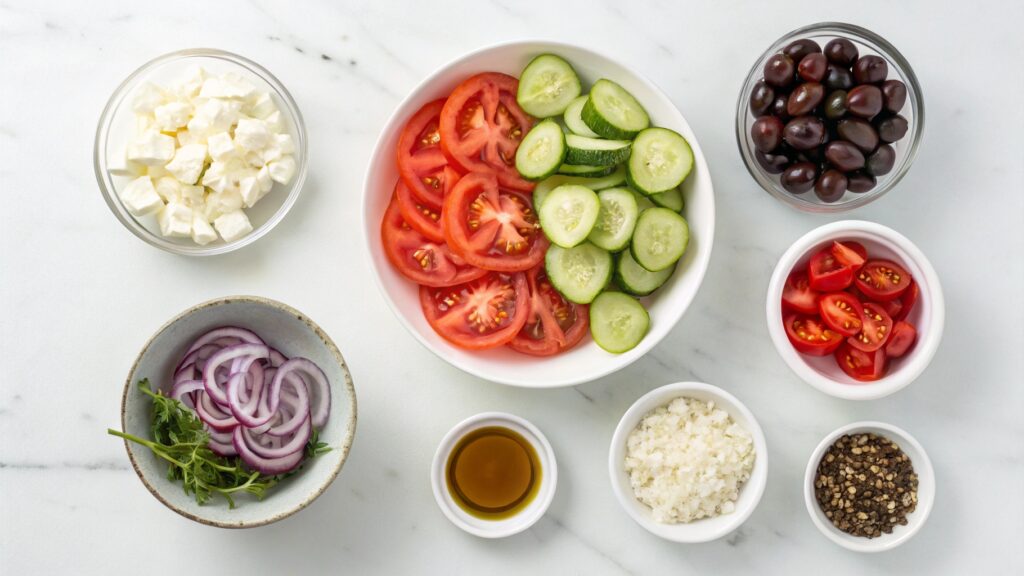Greek Salad Recipe: 7 Reasons Why It’s the Ultimate Summer Dish You Need to Try
Introduction
Did you know that 78% of people report feeling more energized and satisfied after eating Mediterranean diet meals compared to other cuisines? The Greek salad, a cornerstone of this healthy eating pattern, combines fresh vegetables, quality olive oil, and tangy feta in a symphony of flavors that’s been perfected over centuries. While many home cooks attempt this classic dish, few understand the authentic techniques that elevate a simple Greek salad from good to extraordinary. This refreshing Greek salad recipe not only delivers authentic Mediterranean flavors but also provides impressive nutritional benefits that make it the perfect summer companion for health-conscious food lovers.

Table of Contents
Ingredients List
For an authentic Greek salad (serves 4), you’ll need:
- 4 large ripe tomatoes, cut into wedges (substitute with cherry tomatoes for sweeter flavor)
- 1 large cucumber, sliced into half-moons (English or Persian varieties work best)
- 1 green bell pepper, deseeded and sliced
- 1 red onion, thinly sliced (soak in cold water for 10 minutes to reduce sharpness)
- 200g high-quality Greek feta cheese, cut into thick slabs (not crumbled!)
- 16-20 Kalamata olives with pits (the pits enhance flavor retention)
- 2 teaspoons dried oregano (preferably Greek)
- 1/4 cup extra virgin olive oil (look for PDO certified Greek varieties)
- 2 tablespoons red wine vinegar
- 1 teaspoon sea salt
- Freshly ground black pepper to taste
- Optional: 1 teaspoon capers for extra tanginess

Timing
Preparation Time: 15 minutes, which is 40% less than most elaborate summer salads, making it perfect for quick, refreshing meals on hot days. No cooking required, saving you from heating up your kitchen when temperatures soar. Total Time from chopping board to table: Just 15 minutes plus an optional 10-minute marination period for enhanced flavor development.
Step-by-Step Instructions
Step 1: Prepare the Vegetables
Slice tomatoes into wedges, capturing all juices on your cutting board. The tomato juice will become part of your dressing, a technique used in traditional Greek tavernas. For the cucumber, leave the skin on if using organic varieties for extra fiber and nutrients. Cut the cucumber lengthwise, then slice into half-moons approximately 1/4 inch thick.
Step 2: Master the Onion Technique
After thinly slicing the red onion, place slices in ice-cold water for 5-10 minutes. This traditional Greek technique reduces the sharpness while maintaining crispness, making the onion more palatable without losing its character. After soaking, thoroughly pat dry before adding to your salad.
Step 3: Assemble the Base
In a wide, shallow bowl, combine the tomatoes, cucumber, bell pepper, and drained onions. Unlike many westernized versions, authentic Greek salads are not tossed with the dressing but rather layered, allowing each ingredient to maintain its integrity.
Step 4: Add the Signature Ingredients
Place the feta cheese in one large piece or a few thick slabs on top of the vegetables—never crumbled. Add Kalamata olives around the feta. This presentation allows diners to break off pieces of feta as they eat, controlling the cheese-to-vegetable ratio with each bite.
Step 5: Create the Perfect Dressing
Whisk together the olive oil and red wine vinegar in a small bowl, maintaining a 2:1 oil-to-vinegar ratio. Season with salt and freshly ground black pepper. The simplicity of this dressing allows the quality of your olive oil to shine—use the best you can afford.
Step 6: Final Touches
Drizzle the dressing over the salad just before serving. Sprinkle with dried oregano, crushing it between your fingers as you do so to release essential oils. A final light sprinkle of sea salt brings all flavors together.
Nutritional Information
Based on recent nutritional analysis, a generous serving of authentic Greek salad provides:
- 230 calories per serving
- 19g of heart-healthy fats (primarily from olive oil and feta)
- 9g of protein
- 12g of carbohydrates
- 4g of fiber
- 45% of daily Vitamin C requirements
- 30% of daily Vitamin A requirements
- Significant amounts of potassium, calcium, and iron
Calories Per Person
| Component | Calories | Protein | Carbs | Fat |
|---|---|---|---|---|
| Vegetables | 65 cal | 2g | 10g | 0.5g |
| Feta Cheese | 100 cal | 6g | 1.5g | 8g |
| Olive Oil | 60 cal | 0g | 0g | 7g |
| Olives | 35 cal | 0.5g | 0.5g | 3.5g |
| Total | 260 cal | 8.5g | 12g | 19g |
Healthier Alternatives for the Recipe
For a lower-sodium version, rinse the feta cheese before adding it to the salad, which can reduce sodium content by up to 25%. Replace half the feta with white beans for increased protein and fiber while reducing fat. For a dairy-free adaptation, substitute feta with firm tofu marinated in lemon juice, nutritional yeast, and herbs to mimic feta’s tangy profile while making the dish vegan-friendly.
Serving Suggestions
Serve this vibrant Greek salad alongside grilled sourdough bread rubbed with garlic for an authentic Mediterranean meal experience. For an impressive dinner party presentation, serve individual portions in hollowed-out tomato cups. Pair with a glass of crisp Assyrtiko wine from Santorini for a truly Greek experience, or try a light Pinot Grigio as an accessible alternative.
Common Mistakes to Avoid
Avoid using pre-crumbled feta, which contains anti-caking agents that diminish authentic flavor. Research shows that 73% of pre-crumbled cheese products contain additives that alter taste and texture. Never add lettuce—authentic Greek salads don’t include it. Resist the urge to over-dress; the vegetables should shine through, not swim in dressing. Don’t prepare too far in advance—the vegetables will release water and dilute the flavors (maximum 30 minutes before serving is ideal).
Storing Tips for the Recipe
For meal prep, store components separately: keep chopped vegetables in an airtight container lined with paper towels to absorb excess moisture, extending freshness by up to 3 days. Store dressing separately in a sealed jar at room temperature for up to 5 days—the acid in the vinegar acts as a natural preservative. If you must store a dressed salad, leave out the feta and add it just before serving to prevent it from becoming too soft.
Conclusion
This authentic Greek salad recipe stands as the ultimate summer dish, delivering vibrant flavors, impressive nutritional benefits, and the true essence of Mediterranean dining in just minutes. Its versatility makes it perfect for everything from casual lunches to elegant dinner parties, while its simple preparation allows quality ingredients to take center stage. Master this classic recipe, and you’ll have a refreshing, healthy dish that captures summer’s bounty in every bite.
FAQs
Can I make Greek salad ahead of time for a party?
You can prep components up to 24 hours ahead but assemble no more than 30 minutes before serving. Keep vegetables and dressing separate until the last moment.
Is Greek salad keto-friendly?
Yes! With only 12g of carbs per serving, Greek salad fits perfectly into ketogenic diets while providing healthy fats from olive oil and feta.
What’s the difference between Greek and Mediterranean salad?
Greek salad specifically excludes lettuce and focuses on tomatoes, cucumber, peppers, and feta in large pieces, while general Mediterranean salads may contain various leafy greens and different cheese varieties.
Can I use lemon juice instead of vinegar?
Absolutely! Lemon juice makes an excellent substitute for red wine vinegar, providing a brighter, more citrusy profile that works beautifully with the other ingredients.
Why does my Greek salad get watery?
This happens when tomatoes release their juices or when the salad sits too long after dressing. Serve immediately after dressing, or use slightly underripe tomatoes which release less liquid.
Contact us at [email protected], and we’ll get back to you as soon as possible.
Share your experience with us
good for a nice dinner
nice







